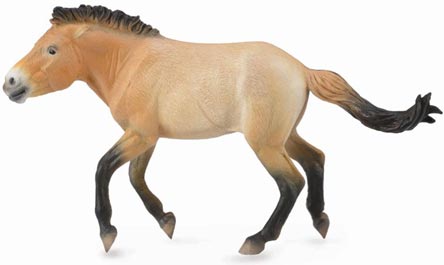Checking on the Progress of a Herd of Wild Horses (Przewalski’s Horse)
The efforts of a conservation team to build up the population of Przewalski’s horses in a remote part of north-western China seem to be succeeding after the survival of a foal born last summer. Recording the number of horses is very difficult, as even though a handful of horses will tolerant the company of humans, most run away when people get within two hundred metres of them. However, the breeding and release programme for the Przewalski’s horse is proving to be a success.
Przewalski’s Horse
The horses, named after a Russian explorer (Nikolai Przhevalsky), once roamed much of Asia and Europe during the Stone Age but with excessive hunting and habitat loss these animals, only distantly related to domesticated horses became all but extinct in the wild. A global conservation effort using animals kept in safari parks and zoos has enabled the numbers of horses to increase and in the latter part of the 20th Century a number of preserves and wild ranges were created allowing some of these remarkable animals to be re-introduced to the wild. One such reserve is the 1.6 million acre West Lake National Nature Reserve in Gansu Province. The reserve is approximately the size of the county of Devon in the United Kingdom.
Extensive Nature Reserve
This nature reserve is one of a number that have been set up around Mongolia and China, the horses being very important symbols in the folklore of these remote areas. However, the freezing winters and very hot summers make life difficult for these tough little horses. To help the herds survive and to get them into a fit condition for breeding extra forage is fed to the animals during the winter and scientists have worked hard to open up new water resources with the establishment of a number of new wells in the protected area.
An official, Sun Zhicheng, explained how the animals were first discovered more than 2,000 years ago telling of an ancient Chinese legend, whereby an exiled criminal came across a horse whilst on the Silk Road. The man had been banished from the oasis of Dunhuang and whilst walking he saw one of these strange, stocky, tan-coloured horses. He made a mannequin and put it on the path where the horse walked, one day he lay down, taking the place of the dummy and he was able to catch the horse which he offered to the Emperor.
The man lied to the Emperor (Han Wudi), claiming that the horse had jumped out of a spring, the Emperor convinced that this horse was a gift of the Gods, kept the animal.
Introducing Przewalski’s Horse
Chinese authorities have been keen to re-introduce Przewalski’s horse (pronounced she-wal-ski or pres-wal-ski) back into the wilds of China.
In 1986 China purchased eighteen of the horses from the United States, Britain and Germany and has since bred them in captivity, with their numbers growing to more than seventy. Three years ago, groups of horses were released into the nature reserve.
Przewalski’s Horse
Picture credit: Everything Dinosaur
According to Sun, numbers have slowly risen, he stated:
“Now there are 27, 16 females and 11 males. We even registered the birth of a foal in July 2011, a new success in our re-introduction process.”
Supplementing the Diet
Przewalski’s horses require daily access to water that is within a 30-kilometre (20-mile) range and does not freeze in winter. They also need 22 pounds (10 kilogrammes) of dry food per day, relatively close to the water. In a region that receives less than 1.5 inches of rain per year, many of these conditions could become problematical, however, help is on hand with park officials ensuring that the grazing horses get their diet supplemented by additional feeding of alfalfa, straw and corn.
Hoping to establish a population of more than one thousand animals in the next fifty years or so, the hard-working team at the West Lake National Nature Reserve hope that they will continue to have success with the breeding programme.
To view the CollectA Przewalski’s horse model and other prehistoric mammal figures: Prehistoric Mammals Models and Figures.



Leave A Comment